Coordinative Unsaturation in an Antimony(III)-Complex with the 2-Salicylidenaminophenolato Ligand: Synthesis, Crystal Structure, Spectroscopic Analysis, and DFT Studies
Abstract
:1. Introduction
2. Materials and Methods
2.1. Calculations
2.2. Methods
2.3. Materials
Ethoxy(2-salicylidenaminophenolato)antimony(III) (LSb)
3. Results and Discussion
3.1. Analytical Methods
3.2. Crystal Structure
3.3. Intrinsic Bond Orbital (IBO) Analysis
3.4. Atoms in Molecules (AIM) Analysis
4. Conclusions
Supplementary Materials
Author Contributions
Funding
Data Availability Statement
Acknowledgments
Conflicts of Interest
References
- Elschenbroich, C. Organometallchemie (Teubner Studienbücher Chemie) (German Edition); Vieweg + Teubner Verlag: Wiesbaden, Germany, 2003; p. 746. ISBN 9783835101678. [Google Scholar]
- Ke, I.-S.; Myahkostupov, M.; Castellano, F.N.; Gabbaï, F.P. Stibonium Ions for the Fluorescence Turn-on Sensing of F− in Drinking Water at Parts Per Million Concentrations. J. Am. Chem. Soc. 2012, 134, 15309–15311. [Google Scholar] [CrossRef] [PubMed]
- Hirai, M.; Gabbaï, F.P. Lewis Acidic Stiborafluorenes for the Fluorescence Turn-on Sensing of Fluoride in Drinking Water at Ppm Concentrations. Chem. Sci. 2014, 5, 1886–1893. [Google Scholar] [CrossRef]
- Li, L.; Zhang, Y.; Li, Y.; Duan, Y.; Qian, Y.; Zhang, P.; Guo, Q.; Ding, J. Polymeric Membrane Fluoride-Selective Electrodes Using Lewis Acidic Organo-Antimony(V) Compounds as Ionophores. ACS Sens. 2020, 5, 3465–3473. [Google Scholar] [CrossRef]
- Jones, J.S.; Gabbaï, F.P. Coordination- and Redox-Noninnocent Behavior of Ambiphilic Ligands Containing Antimony. Acc. Chem. Res. 2016, 49, 857–867. [Google Scholar] [CrossRef] [PubMed]
- Akiba, K.-Y.; Ohnari, H.; Ohkata, K. Oxidation of α-Hydroxyketones with Triphenylantimony Dibromide and Its Catalytic Cycle. Chem. Lett. 1985, 14, 1577–1580. [Google Scholar] [CrossRef]
- Huang, Y.; Shen, Y.; Chen, C. Bromodiphenylstibine-Mediated Oxidation of Benzyl Alcohols by Bromine. Synthesis 1985, 1985, 651–652. [Google Scholar] [CrossRef]
- Yang, M.; Tofan, D.; Chen, C.-H.; Jack, K.M.; Gabbaï, F.P. Digging the Sigma-Hole of Organoantimony Lewis Acids by Oxidation. Angew. Chem. Int. Ed. 2018, 57, 13868–13872. [Google Scholar] [CrossRef]
- Yang, M.; Pati, N.; Bélanger-Chabot, G.; Hirai, M.; Gabbaï, F.P. Influence of the Catalyst Structure in the Cycloaddition of Isocyanates to Oxiranes Promoted by Tetraarylstibonium Cations. Dalton Trans. 2018, 47, 11843–11850. [Google Scholar] [CrossRef]
- Shraim, A.M.; Salih, K.S.M.; Al-Soufi, R.E.; Al-Mhini, S.R.; Ahmad, M.I.; Warad, I. Synthesis of Novel Aqua 4-NNNO/Cu(II) Complexes as Rapid and Selective Oxidative Catalysts for O-Catechol: Fluorescence, Spectral, Chromotropism and Thermal Analyses. Crystals 2021, 11, 1072. [Google Scholar] [CrossRef]
- Gericke, R. Neuartige Pnictogen-Ruthenium-Komplexe Mit Bidentaten (O,N)-Brückenliganden. Ph.D. Thesis, TU Bergakademie Freiberg, Freiberg, Germany, 2018. [Google Scholar]
- Hovenkamp, S.G. Kinetic Aspects of Catalyzed Reactions in the Formation of Poly(ethylene Terephthalate). J. Polym. Sci. Part A-1 Polym. Chem. 1971, 9, 3617–3625. [Google Scholar] [CrossRef]
- Nomura, R.; Nakano, T.; Yamada, Y.; Matsuda, H. Facile One-Pot Amidation of Carboxylic Acids by Amines Catalyzed by Triphenylstibine Oxide/tetraphosphorus Decasulfide (Ph3SbO/P4S10). J. Org. Chem. 1991, 56, 4076–4078. [Google Scholar] [CrossRef]
- Marczenko, K.M.; Zurakowski, J.A.; Bamford, K.L.; MacMillan, J.W.M.; Chitnis, S.S. Hydrostibination. Angew. Chem. Int. Ed. 2019, 58, 18096–18101. [Google Scholar] [CrossRef] [PubMed]
- Tofan, D.; Gabbaï, F.P. Fluorinated Antimony(V) Derivatives: Strong Lewis Acidic Properties and Application to the Complexation of Formaldehyde in Aqueous Solutions. Chem. Sci. 2016, 7, 6768–6778. [Google Scholar] [CrossRef] [PubMed]
- Lipshultz, J.M.; Li, G.; Radosevich, A.T. Main Group Redox Catalysis of Organopnictogens: Vertical Periodic Trends and Emerging Opportunities in Group 15. J. Am. Chem. Soc. 2021, 143, 1699–1721. [Google Scholar] [CrossRef] [PubMed]
- Abbenseth, J.; Goicoechea, J.M. Recent Developments in the Chemistry of Non-Trigonal Pnictogen Pincer Compounds: From Bonding to Catalysis. Chem. Sci. 2020, 11, 9728–9740. [Google Scholar] [CrossRef]
- Siedzielnik, M.; Pantazis, D.A.; Bruniecki, J.; Kaniewska-Laskowska, K.; Dołęga, A. The Reactivity of the Imine Bond Within Polynuclear Nickel(II) Complexes. Crystals 2021, 11, 512. [Google Scholar] [CrossRef]
- Novoa-Ramírez, C.S.; Silva-Becerril, A.; Olivera-Venturo, F.L.; García-Ramos, J.C.; Flores-Alamo, M.; Ruiz-Azuara, L. N/N Bridge Type and Substituent Effects on Chemical and Crystallographic Properties of Schiff-Base (Salen/Salphen) Niii Complexes. Crystals 2020, 10, 616. [Google Scholar] [CrossRef]
- Baul, T.S.B.; Chaurasiya, A.; Rabha, M.; Khatua, S.; Lyčka, A.; Schollmeyer, D.; Jurkschat, K. Diorganotin Compounds Containing -Aminoacidato Schiff Base Ligands Derived from Functionalized 2-Hydroxy-5-(Aryldiazenyl)benzaldehyde. Syntheses, Structures and Sensing of Hydrogen Sulfide. Eur. J. Inorg. Chem. 2020, 2020, 1803–1813. [Google Scholar] [CrossRef]
- Böhme, U.; Wiesner, S.; Günther, B. Easy Access to Chiral Penta- and Hexacoordinate Silicon Compounds. Inorg. Chem. Commun. 2006, 9, 806–809. [Google Scholar] [CrossRef]
- Paul, L.E.H.; Foehn, I.C.; Schwarzer, A.; Brendler, E.; Böhme, U. Salicylaldehyde-(2-Hydroxyethyl)imine—A Flexible Ligand for Group 13 and 14 Elements. Inorg. Chim. Acta 2014, 423, 268–280. [Google Scholar] [CrossRef]
- Schwarzer, S.; Böhme, U.; Fels, S.; Günther, B.; Brendler, E. (S)-N-[(2-Hydroxynaphthalen-1-Yl)methylidene]valine—A Valuable Ligand for the Preparation of Chiral Complexes. Inorg. Chim. Acta 2018, 483, 136–147. [Google Scholar] [CrossRef]
- Warncke, G.; Böhme, U.; Günther, B.; Kronstein, M. Racemization Versus Retention of Chiral Information During the Formation of Silicon and Tin Complexes with Chiral Schiff Base Ligands. Polyhedron 2012, 47, 46–52. [Google Scholar] [CrossRef]
- Soroceanu, A.; Bargan, A. Advanced and Biomedical Applications of Schiff-Base Ligands and Their Metal Complexes: A Review. Crystals 2022, 12, 1436. [Google Scholar] [CrossRef]
- Nath, M.; Saini, P.K. Chemistry and Applications of Organotin(iv) Complexes of Schiff Bases. Dalton Trans. 2011, 40, 7077. [Google Scholar] [CrossRef]
- Sanmartín-Matalobos, J.; García-Deibe, A.; Zarepour-Jevinani, M.; Aboal-Somoza, M.; Bermejo-Barrera, P.; Fondo, M. Exploring the Chelating Potential of an Easily Synthesized Schiff Base for Copper Sensing. Crystals 2020, 10, 235. [Google Scholar] [CrossRef]
- Kamaal, S.; Mehkoom, M.; Muslim, M.; Afzal, S.M.; Alarifi, A.; Afzal, M.; Alowais, A.; Muddassir, M.; Albalwi, A.N.; Ahmad, M. Crystal Structure, Topological and Hirshfeld Surface Analysis of a Zn(II) Zwitterionic Schiff Base Complex Exhibiting Nonlinear Optical (NLO) Properties Using Z-Scan Technique. Crystals 2021, 11, 508. [Google Scholar] [CrossRef]
- You, Z.; Luo, Y.; Herringer, S.; Li, Y.; Decurtins, S.; Krämer, K.W.; Liu, S.-X. Formation of Tetranuclear Nickel(II) Complexes with Schiff-Bases: Crystal Structures and Magnetic Properties. Crystals 2020, 10, 592. [Google Scholar] [CrossRef]
- Raptopoulou, C.P. Heterometallic Complexes Containing the NiII-LnIII-NiII Moiety—Structures and Magnetic Properties. Crystals 2020, 10, 1117. [Google Scholar] [CrossRef]
- Dermitzaki, D.; Panagiotopoulou, A.; Pissas, M.; Sanakis, Y.; Psycharis, V.; Raptopoulou, C.P. Synthesis, Crystal Structures and Magnetic Properties of Trinuclear {Ni2Ln} (LnIII = Dy, Ho) and {Ni2Y} Complexes with Schiff Base Ligands. Crystals 2022, 12, 95. [Google Scholar] [CrossRef]
- Sharma, P.; Cabrera, A.; Singh, S.; Jha, N.K. Schiff Base Complexes of Antimony: A Review. Main Group Met. Chem. 1997, 20, 551–566. [Google Scholar] [CrossRef]
- Stephan, D.W.; Erker, G. Frustrated Lewis Pair Chemistry: Development and Perspectives. Angew. Chem. Int. Ed. 2015, 54, 6400–6441. [Google Scholar] [CrossRef]
- Stephan, D.W. Discovery of Frustrated Lewis Pairs: Intermolecular FLPs for Activation of Small Molecules. In Topics in Current Chemistry; Springer: Berlin/Heidelberg, Germany, 2012; pp. 1–44. [Google Scholar] [CrossRef]
- Greb, L.; Ebner, F.; Ginzburg, Y.; Sigmund, L.M. Element-Ligand Cooperativity with p-Block Elements. Eur. J. Inorg. Chem. 2020, 2020, 3030–3047. [Google Scholar] [CrossRef]
- Arduengo, A.J.; Stewart, C.A.; Davidson, F.; Dixon, D.A.; Becker, J.Y.; Culley, S.A.; Mizen, M.B. The Synthesis, Structure, and Chemistry of 10-Pn-3 Systems: Tricoordinate Hypervalent Pnicogen Compounds. J. Am. Chem. Soc. 1987, 109, 627–647. [Google Scholar] [CrossRef]
- Stewart, C.A.; Harlow, R.L.; Arduengo, A.J. Chemistry and Structure of the First 10-Sb-3 Species. J. Am. Chem. Soc. 1985, 107, 5543–5544. [Google Scholar] [CrossRef]
- Neese, F. Software Update: The ORCA Program system—Version 5.0. WIREs Comput. Mol. Sci. 2022, 12, e1606. [Google Scholar] [CrossRef]
- Brandenburg, J.G.; Bannwarth, C.; Hansen, A.; Grimme, S. B97-3c: A Revised Low-Cost Variant of the B97-D Density Functional Method. J. Chem. Phys. 2018, 148, 064104. [Google Scholar] [CrossRef] [PubMed]
- Barone, V.; Cossi, M. Quantum Calculation of Molecular Energies and Energy Gradients in Solution by a Conductor Solvent Model. J. Phys. Chem. A 1998, 102, 1995–2001. [Google Scholar] [CrossRef]
- Knizia, G. Intrinsic Atomic Orbitals: An Unbiased Bridge Between Quantum Theory and Chemical Concepts. J. Chem. Theory Comput. 2013, 9, 4834–4843. [Google Scholar] [CrossRef]
- Adamo, C.; Barone, V. Toward Reliable Density Functional Methods without Adjustable Parameters: The PBE0 Model. J. Chem. Phys. 1999, 110, 6158–6170. [Google Scholar] [CrossRef]
- Perdew, J.P.; Ernzerhof, M.; Burke, K. Rationale for Mixing Exact Exchange with Density Functional Approximations. J. Chem. Phys. 1996, 105, 9982–9985. [Google Scholar] [CrossRef]
- Weigend, F.; Ahlrichs, R. Balanced Basis Sets of Split Valence, Triple Zeta Valence and Quadruple Zeta Valence Quality for H to Rn: Design and Assessment of Accuracy. Phys. Chem. Chem. Phys. 2005, 7, 3297. [Google Scholar] [CrossRef] [PubMed]
- UVVis Spectroscopy. Available online: https://www.orcasoftware.de/tutorials_orca/spec/UVVis.html (accessed on 24 July 2023).
- Becke, A.D. Density-Functional Thermochemistry. III. the Role of Exact Exchange. J. Chem. Phys. 1993, 98, 5648–5652. [Google Scholar] [CrossRef]
- Stephens, P.J.; Devlin, F.J.; Chabalowski, C.F.; Frisch, M.J. Ab Initio Calculation of Vibrational Absorption and Circular Dichroism Spectra Using Density Functional Force Fields. J. Phys. Chem. 1994, 98, 11623–11627. [Google Scholar] [CrossRef]
- Vosko, S.H.; Wilk, L.; Nusair, M. Accurate Spin-Dependent Electron Liquid Correlation Energies for Local Spin Density Calculations: A Critical Analysis. Can. J. Phys. 1980, 58, 1200–1211. [Google Scholar] [CrossRef]
- Herbig, M. Reaktivität Von CO2 Gegenüber Si-N-Bindungen. Ph.D. Thesis, TU Bergakademie Freiberg, Freiberg, Germany, 2020. [Google Scholar]
- Stoe & Cie GmbH, X-RED and X-AREA, Version 1.53 and Version 1.55; Stoe & Cie GmbH: Darmstadt, Germany, 2009.
- Sheldrick, G.M. A Short History of SHELX. Acta Crystallogr. Sect. A: Found. Crystallogr. 2007, 64, 112–122. [Google Scholar] [CrossRef]
- Sheldrick, G.M. Crystal Structure Refinement with SHELXL. Acta Crystallogr. Sect. C: Struct. Chem. 2015, 71, 3–8. [Google Scholar] [CrossRef]
- Böhme, U.; Herbig, M. New Complexes of Antimony(III) with Tridentate O,E,O-Ligands (E = O, S, Se, Te, NH, NMe) Derived from N-Methyldiethanolamine. Molecules 2023, 28, 4959. [Google Scholar] [CrossRef]
- Katsyuba, S.A.; Zvereva, E.E.; Grimme, S. Fast Quantum Chemical Simulations of Infrared Spectra of Organic Compounds with the B97-3c Composite Method. J. Phys. Chem. A 2019, 123, 3802–3808. [Google Scholar] [CrossRef] [PubMed]
- Cambridge Structural Database, Verson 5.44 (April 2023). Available online: https://www.ccdc.cam.ac.uk/ (accessed on 1 June 2023).
- Vandenbergen, A.M.; Cashion, J.D.; Fallon, G.D.; West, B.O. Crystal Structures, Mössbauer Spectra and Reactivity of Sn,II Salicylideneimines. Aust. J. Chem. 1990, 43, 1559. [Google Scholar] [CrossRef]
- Noller, H. (Ed.) Values for Atomic Radii Taken from: Pauling, L. Die Natur Der Chemischen Bindung, 3rd ed.; Verl. Chemie: Weinheim/Bergstraße, Germany, 1962; Values are: R(Sb) = 1.41, r(O) = 0.66, r(N) = 0.7 Å. [Google Scholar]
- Bianca, F.D.; Rivarola, E.; Spek, A.L.; Meinema, H.A.; Noltes, J.G. Investigations on Organoantimony Compounds: XI. Triorganoantimony(V) Compounds Containing Potentially Tridentate Ligands. J. Organomet. Chem. 1973, 63, 293–300. [Google Scholar] [CrossRef]
- Böhme, U.; Günther, B. Five and Six-Coordinate Silicon Complexes with an O,N,O′-Chelating Ligand Derived from O-Hydroxyacetophenone–N-(2-Hydroxyethyl)imine. Inorg. Chem. Commun. 2007, 10, 482–484. [Google Scholar] [CrossRef]
- Böhme, U.; Foehn, I.C. Two Modifications of a Five-Coordinate Silicon Complex. Acta Crystallogr. Sect. C Cryst. Struct. Commun. 2007, 63, o613–o616. [Google Scholar] [CrossRef] [PubMed]
- Schwarzer, A.; Paul, L.E.H.; Böhme, U. Enantiotropic Phase Transition in a Binuclear Tin Complex with an O,N,O-Tridentate Ligand. Acta Crystallogr. Sect. C Cryst. Struct. Commun. 2013, 69, 1336–1339. [Google Scholar] [CrossRef]
- Values for Van der Waals-radii taken from: Mantina, M.; Chamberlin, A.C.; Valero, R.; Cramer, C.J.; Truhlar, D.G. Consistent Van Der Waals Radii for the Whole Main Group. J. Phys. Chem. A 2009, 113, 5806–5812, Values are: R(Sb) = 2.06, r(O) = 1.52. [Google Scholar] [CrossRef]
- Ketkaew, R.; Tantirungrotechai, Y.; Harding, P.; Chastanet, G.; Guionneau, P.; Marchivie, M.; Harding, D.J. OctaDist: A Tool for Calculating Distortion Parameters in Spin Crossover and Coordination Complexes. Dalton Trans. 2021, 50, 1086–1096. [Google Scholar] [CrossRef]
- Macchi, P.; Proserpio, D.M.; Sironi, A. Experimental Electron Density in a Transition Metal Dimer:0.167em Metal-Metal and Metal-Ligand Bonds. J. Am. Chem. Soc. 1998, 120, 13429–13435, : , 2015; p. 914. [Google Scholar] [CrossRef]
- Schwetlick, K. Organikum, Organisch-Chemisches Grundpraktikum, 24. Aufl.; Wiley-VCH: Weinheim, Germany, 2015; p. 914. [Google Scholar]
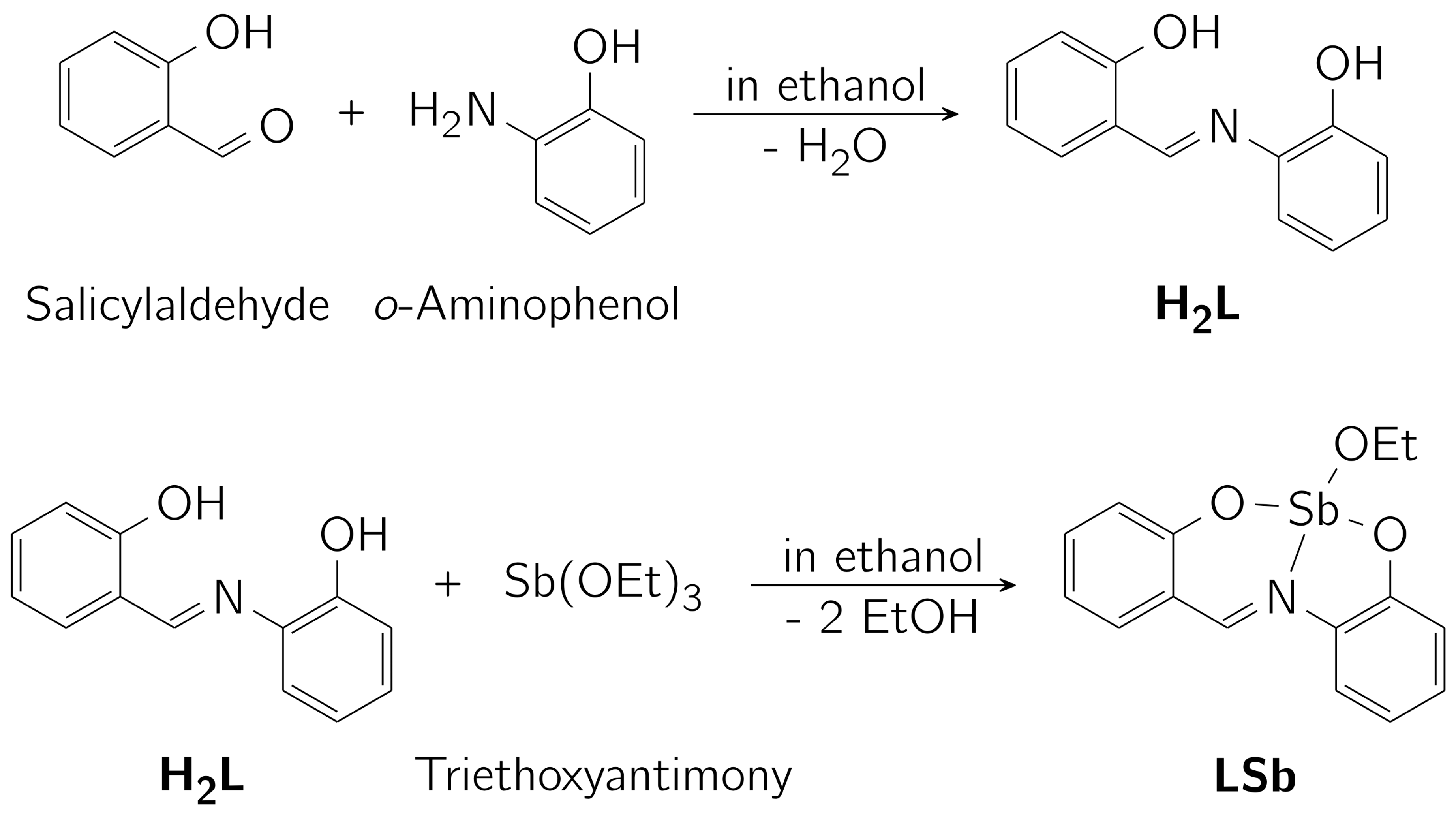
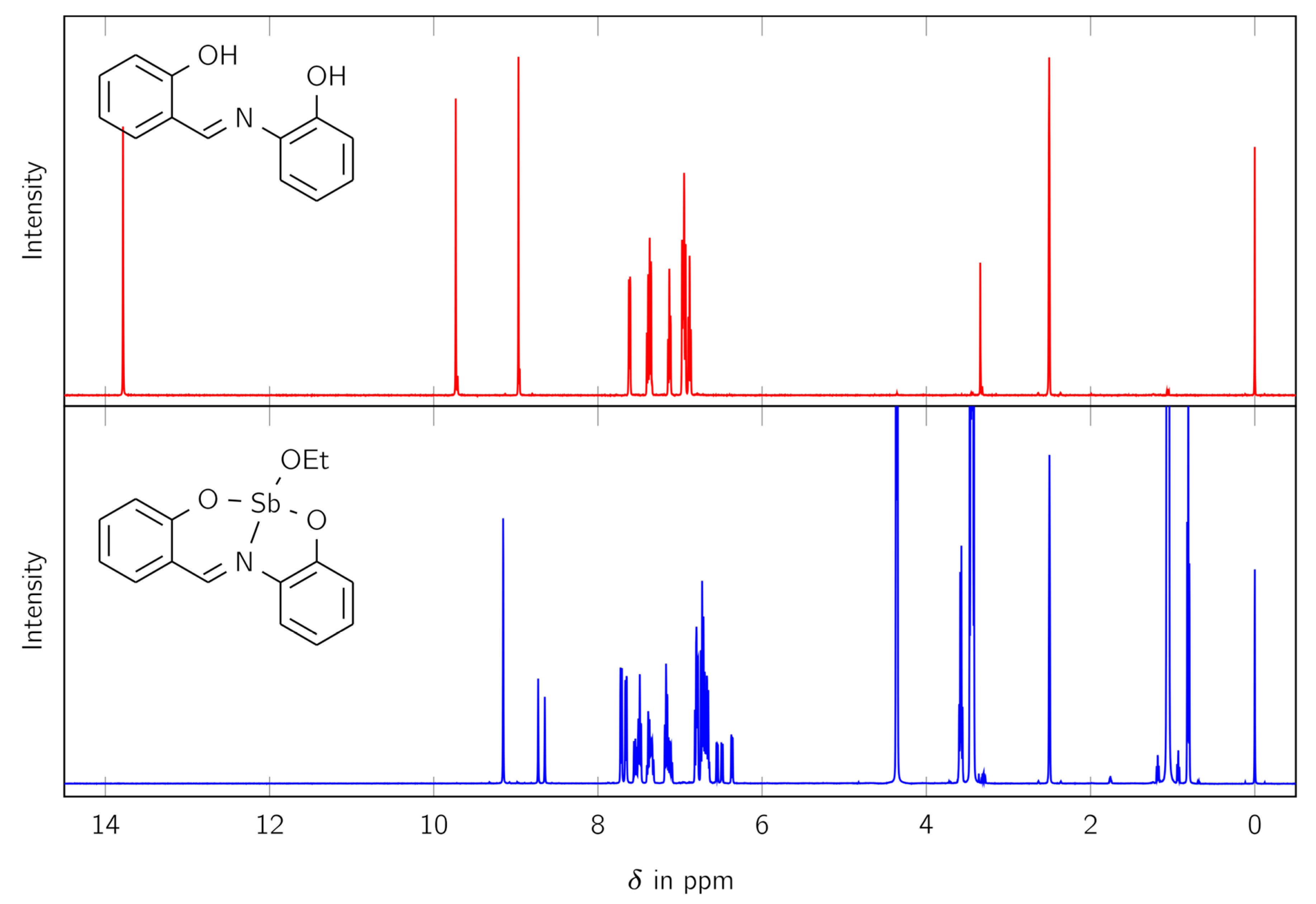

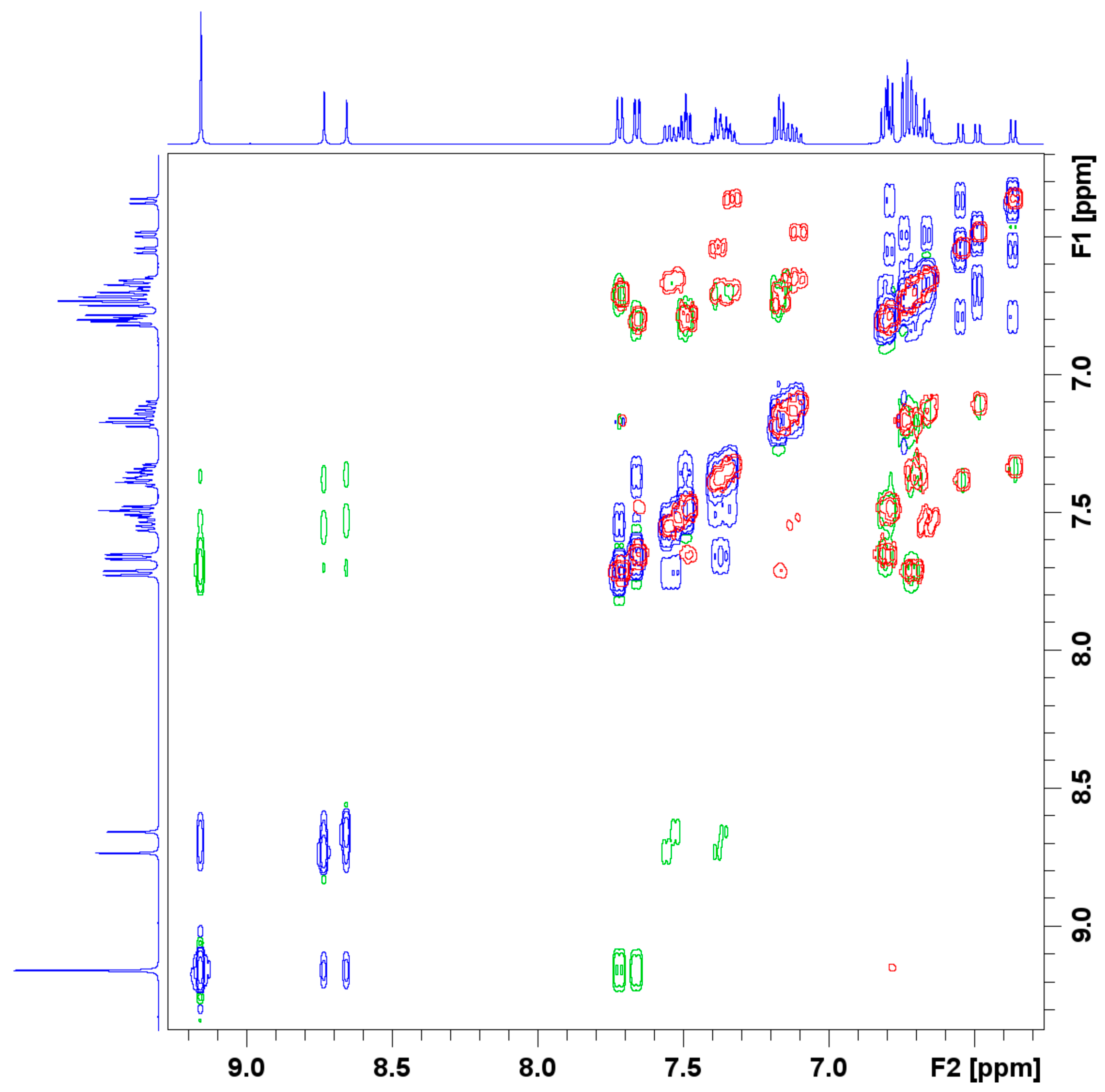
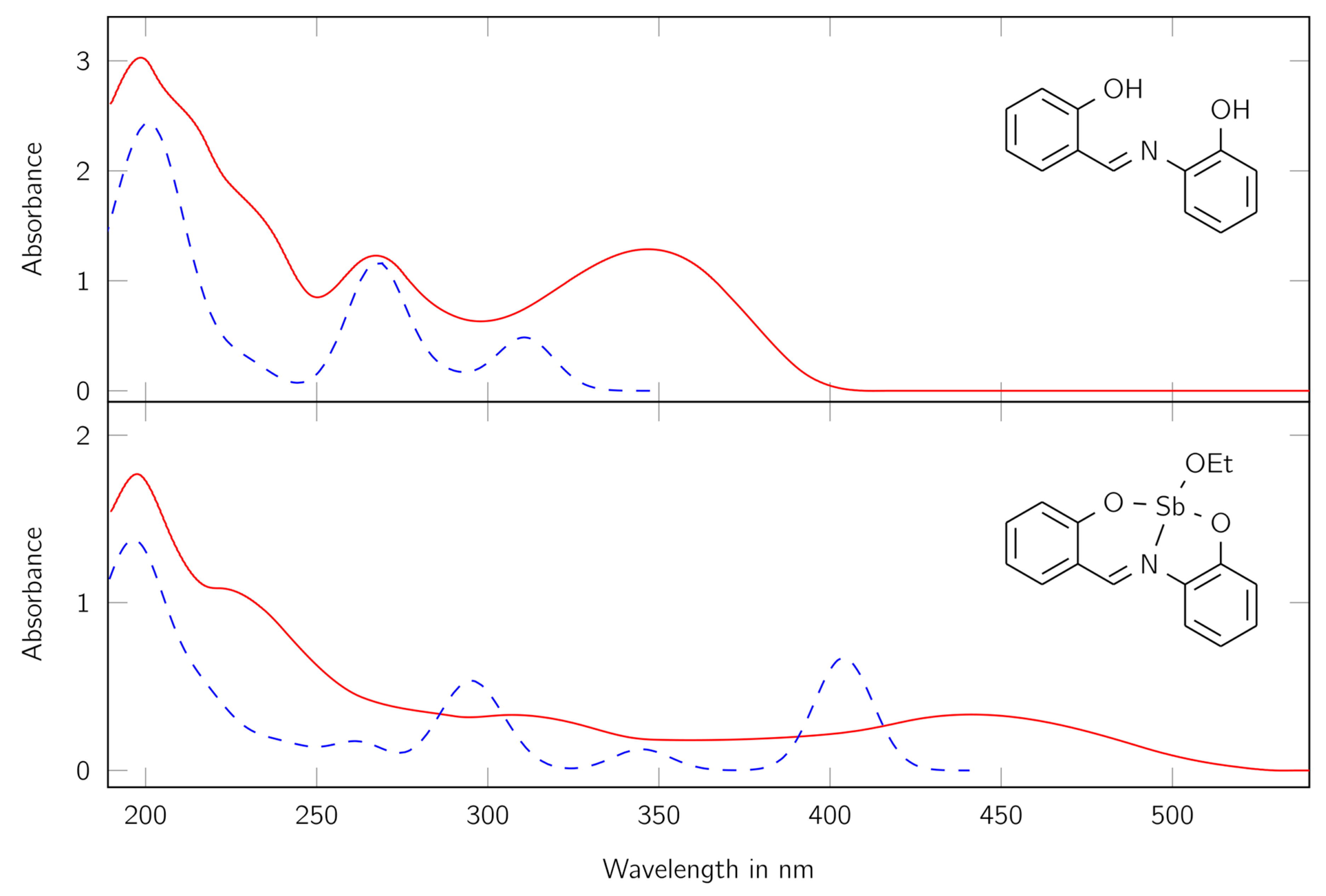

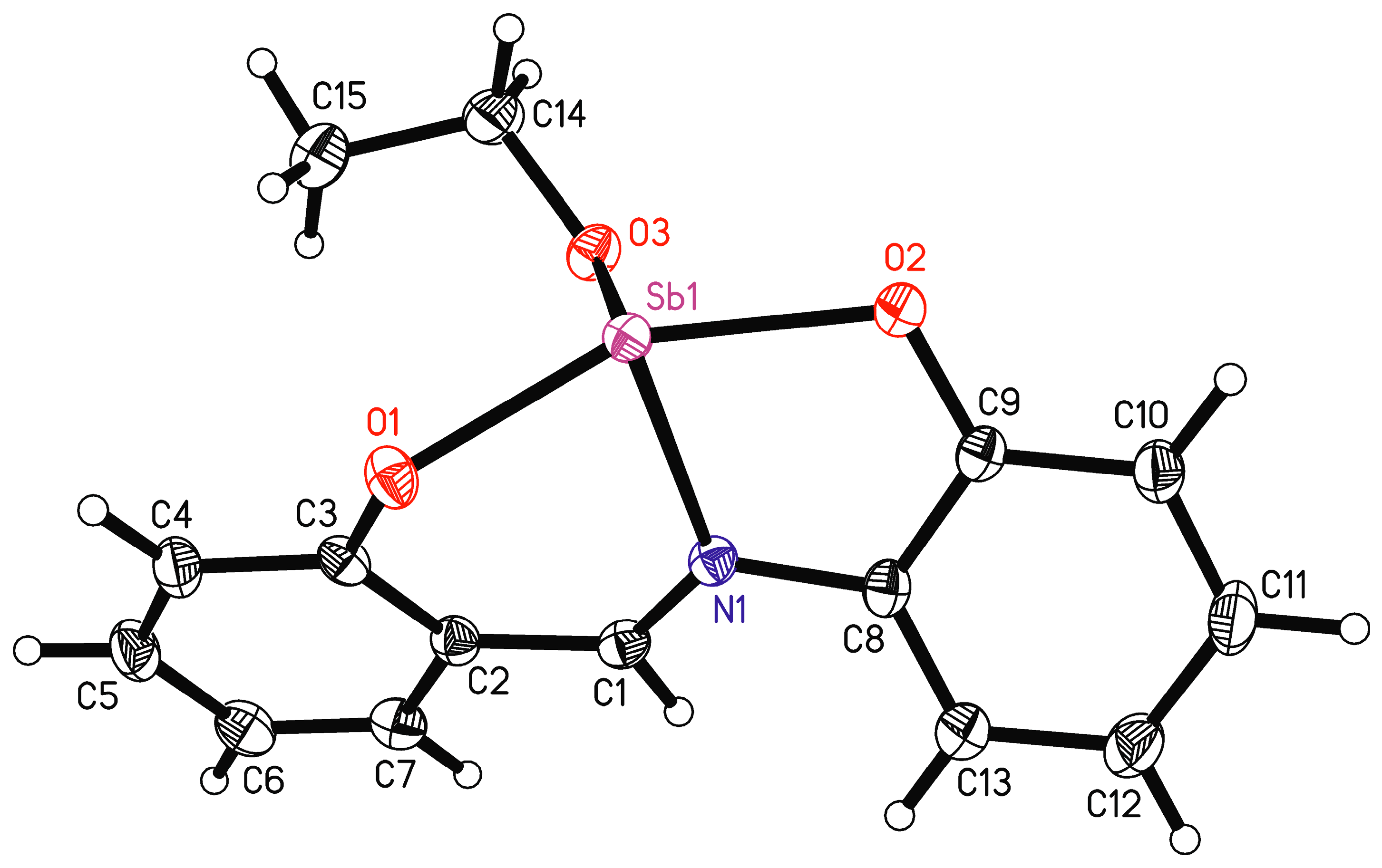
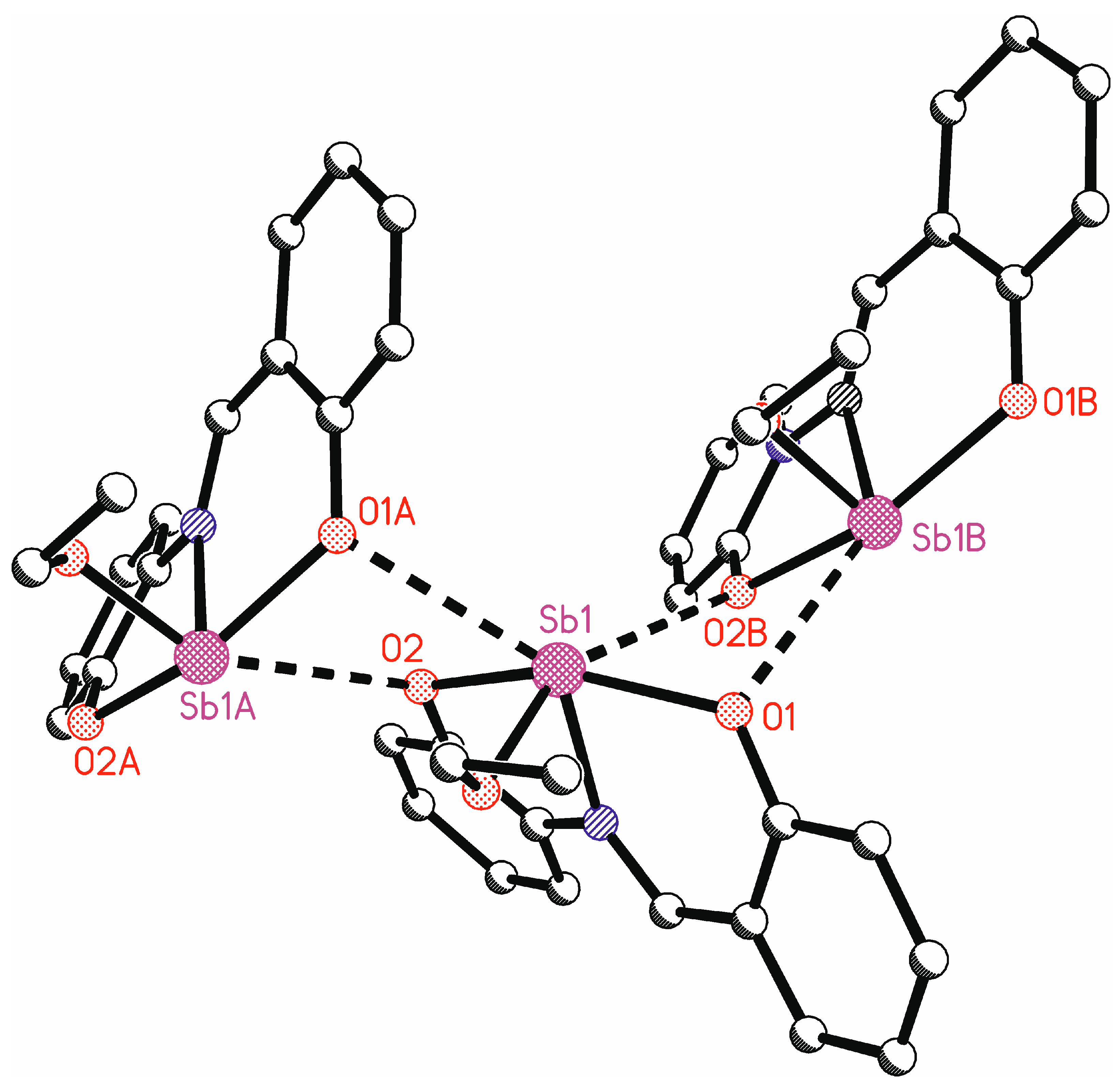
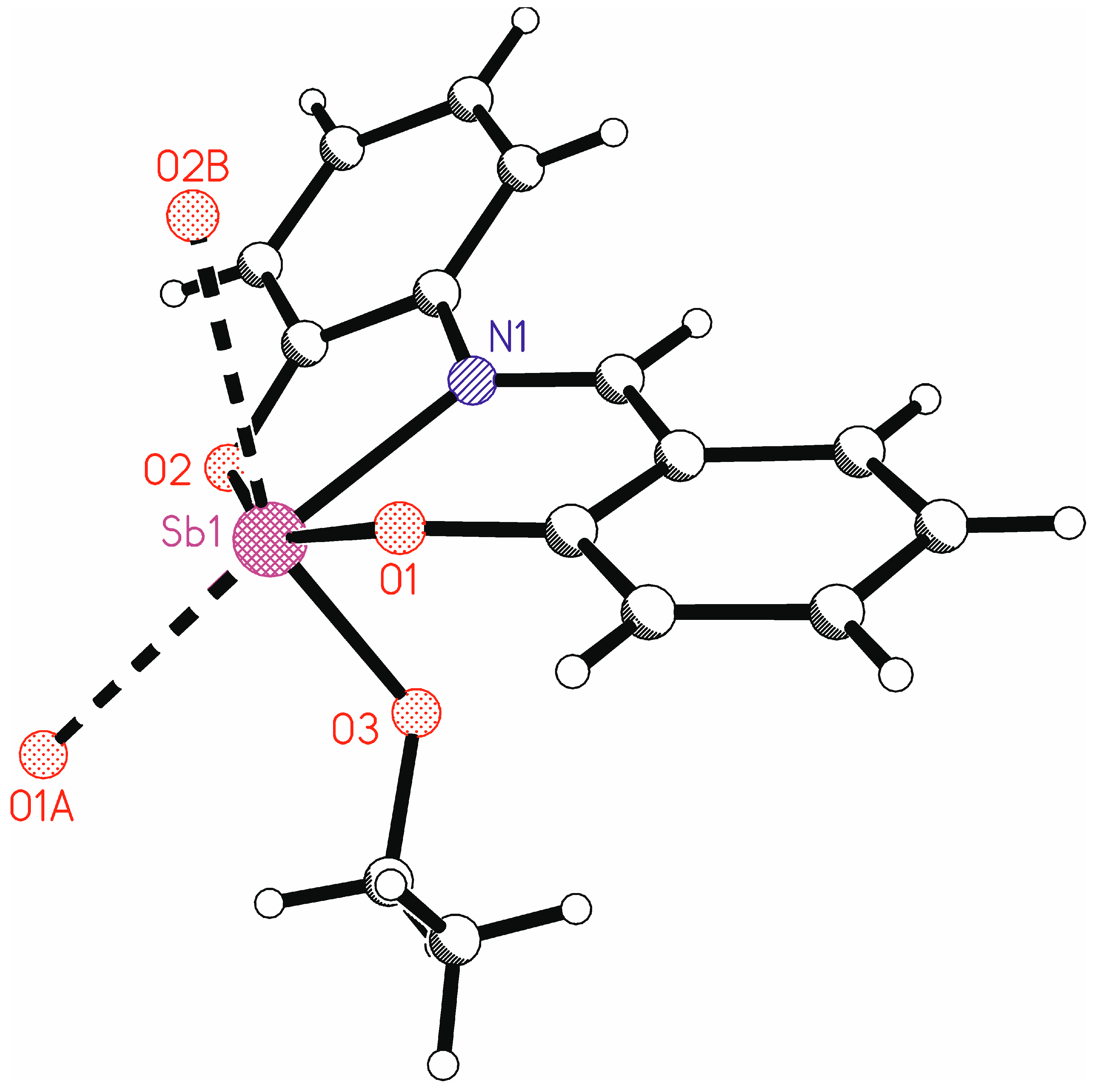
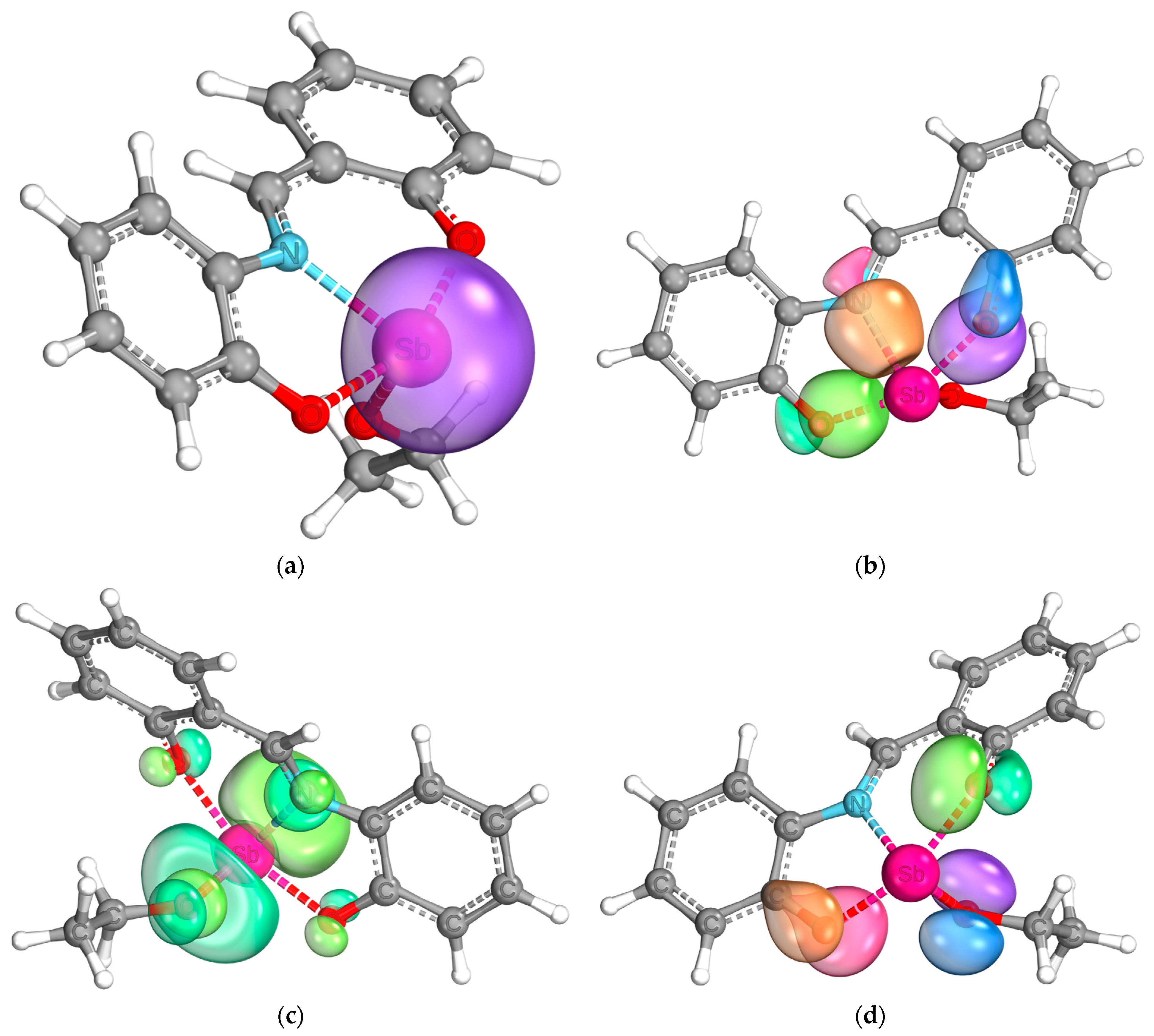

| Parameter | Value |
|---|---|
| Formula | C15H14NO3Sb |
| Mr | 378.02 |
| T (K) | 153 |
| λ (Å) | 0.71073 |
| Crystal system | Monoclinic |
| Space group | P21/c |
| a (Å) | 10.8915(6) |
| b (Å) | 16.5156(6) |
| c (Å) | 7.7866(4) |
| α (°) | 90 |
| β (°) | 104.932(4) |
| γ (°) | 90 |
| V (Å3) | 1353.35(12) |
| Z | 4 |
| ρcalc (g·cm−3) | 1.855 |
| μ (mm−1) | 2.045 |
| F(000) | 744 |
| θmax (°) | 27.647 |
| Reflections collected/unique [Rint] | 19,113/3130 [R(int) = 0.0209] |
| Completeness to θ = 25.242° | 99.8% |
| Absorption correction | Integration |
| Max. and min. transmission | 0.8002 and 0.5865 |
| Data/restraints/parameters | 3130/0/183 |
| GoF on F2 | 1.234 |
| Final R indices [I > 2sigma(I)] | R1 = 0.0231, wR2 = 0.0551 |
| R indices (all data) | R1 = 0.0257, wR2 = 0.0571 |
| Extinction coefficient | 0.0057(5) |
| Largest peak and hole (e·Å−3) | 0.442 and −0.549 |
| Parameter | Value |
|---|---|
| Sb1-O1 | 2.1402(17) |
| Sb1-O2 | 2.1496(18) |
| Sb1-O3 | 1.9716(18) |
| Sb1-N1 | 2.194(2) |
| N1-C1 | 1.299(3) |
| N1-C8 | 1.421(3) |
| Sb1...O1A i | 2.9834(18) |
| Sb1...O2B ii | 2.9344(18) |
| O2-Sb1-N1 | 74.20(7) |
| O1-Sb1-N1 | 80.56(7) |
| O3-Sb1-N1 | 84.04(7) |
| O3-Sb1-O1 | 90.84(7) |
| O3-Sb1-O2 | 91.48(7) |
| O1-Sb1-O2 | 154.27(7) |
| O1-Sb1...O1A i | 137.46(8) |
| O1-Sb1...O2B ii | 69.09(6) |
| O2-Sb1...O1A i | 67.96(6) |
| O2-Sb1...O2B ii | 99.39(6) |
| N1-Sb1…O2B ii | 75.86(6) |
| O3-Sb1…O1A i | 78.85(6) |
| O3-Sb1…O2B ii | 153.44(7) |
| N1-Sb1…O1A i | 137.71(6) |
| O1A i…Sb1…O2B ii | 127.68(5) |
| Bond | H(r) [Eh a0−3] | G(r)/ρ(r) [Eh e−1] | L(r) [e a0−5] | ρ(r) [e a0−3] | Bond Type |
|---|---|---|---|---|---|
| Sb-O1 | −0.017 | 1.400 | −0.655 | 0.129 | Polar shared bond |
| Sb-O2 | −0.032 | 1.252 | −0.647 | 0.155 | Polar shared bond |
| Sb-O3 | −0.064 | 1.334 | −0.883 | 0.213 | Polar shared bond |
| Sb-N | −0.014 | 1.159 | −0.505 | 0.121 | Polar shared bond |
Disclaimer/Publisher’s Note: The statements, opinions and data contained in all publications are solely those of the individual author(s) and contributor(s) and not of MDPI and/or the editor(s). MDPI and/or the editor(s) disclaim responsibility for any injury to people or property resulting from any ideas, methods, instructions or products referred to in the content. |
© 2023 by the authors. Licensee MDPI, Basel, Switzerland. This article is an open access article distributed under the terms and conditions of the Creative Commons Attribution (CC BY) license (https://creativecommons.org/licenses/by/4.0/).
Share and Cite
Knerr, S.; Böhme, U.; Herbig, M. Coordinative Unsaturation in an Antimony(III)-Complex with the 2-Salicylidenaminophenolato Ligand: Synthesis, Crystal Structure, Spectroscopic Analysis, and DFT Studies. Crystals 2023, 13, 1300. https://doi.org/10.3390/cryst13091300
Knerr S, Böhme U, Herbig M. Coordinative Unsaturation in an Antimony(III)-Complex with the 2-Salicylidenaminophenolato Ligand: Synthesis, Crystal Structure, Spectroscopic Analysis, and DFT Studies. Crystals. 2023; 13(9):1300. https://doi.org/10.3390/cryst13091300
Chicago/Turabian StyleKnerr, Steven, Uwe Böhme, and Marcus Herbig. 2023. "Coordinative Unsaturation in an Antimony(III)-Complex with the 2-Salicylidenaminophenolato Ligand: Synthesis, Crystal Structure, Spectroscopic Analysis, and DFT Studies" Crystals 13, no. 9: 1300. https://doi.org/10.3390/cryst13091300







